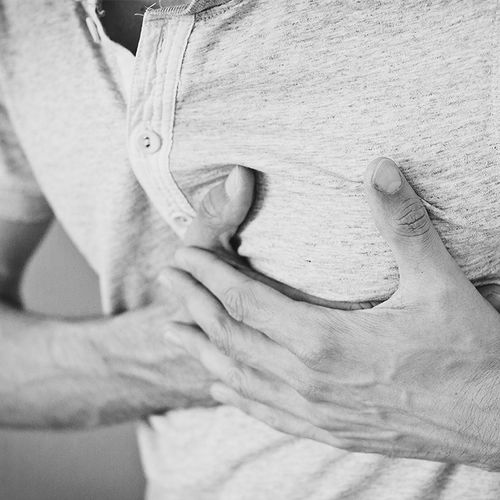Virtually everyone feels chest pain at some point-and for good reason. Any of the organs in the chest, as well as the chest wall itself, can cause pain.
While severe pain is clearly something that you should pay close attention to, lesser degrees of pain also can indicate trouble. Surprisingly, mild chest pain can signal a heart attack, while some severe pains may not always be serious (such as pains due to sore muscles).
Your health-and, in some cases, your life—depends on knowing when chest pain indicates a serious condition that needs immediate attention.
Important: If you experience any feeling in your chest that's new or that you don't understand especially if it persists-consult a doctor.
Some possible causes of chest pain-and what each may mean…
It’s The Heart!
- Heart attack. Typical symptoms are pressure, squeezing or heaviness behind the breastbone in the center of your chest, often associated with nausea, sweating, light-headedness or shortness of breath.
This could signal a heart attack, caused when blood flow to the heart is cut off by a blood clot in a coronary artery. Many people mistakenly think the heart is located on the left side of the chest (because they feel their heartbeat there), but it's actually in the center-so pain in the center—so pain in the mid-chest should be taken seriously.
What you may not know: It's common to have a history of milder chest pain in the center of the chest preceding (by up to two weeks in some cases, the more severe pain of a heart attack. Pain from a heart attack also can radiate to one or both shoulders and arms (especially the left) or to the neck or jaw.
If you suffer mid-chest pain, call 911 and get to a hospital emergency department as quickly as possible! Do not wait to see if the pain goes away. Prompt treatment will minimize damage to your heart muscle and may save your life.
- Stable angina pectoris. Typical symptoms are crushing pain or mild to moderate squeezing, tightness or heaviness in the middle of the chest brought on by physical exertion, emotional stress or cold weather-all of which can increase the work of the heart. Pain is relieved by rest and usually lasts five minutes or less.
The pain of angina pectoris indicates insufficient blood flow to the heart muscle, usually due to partial blockages from fatty deposits that narrow one or more coronary arteries. While this pain isn't a medical emergency like a heart attack, it's a sign that you need to schedule a doctor visit.
- Unstable angina pectoris. Typical symptoms are unexplained pain (not necessarily severe) in the middle of the chest, tightness, constriction, squeezing or heaviness and/or pain in the neck, left shoulder or left arm. These symptoms persist and/or may occur while you're at rest or awaken you at night.
Associated with significantly impaired blood flow to the heart muscle, unstable angina pectoris frequently indicates an impending heart attack. If you experience these symptoms, go to a hospital emergency department immediately.
The Heart Is Not The Culprit
- Lung condition. Typical symptoms are sharp pain in either side of the chest, made worse by breathing.
This may indicate a lung problem such as pneumonia pleurisy (inflammation of the surface lining of a lung)...or a blood clot that formed elsewhere (usually in a leg vein), broke off and traveled to the lungs. A pulmonary blood clot is life-threatening and requires hospitalization and treatment.
- Aortic dissection. A typical symptom is a usually excruciating, tearing pain in the chest or between the shoulder blades.
This pain arises from dissection of the aorta (the large artery that carries blood from the left ventricle to the rest of the body) and occurs when blood from the aorta burrows between the layers of its wall. This condition is a major emergency requiring immediate medical care.
Less Serious Chest Pains
- Acid reflux. Typical symptoms include a burning discomfort in the middle of the chest that may radiate to the throat, usually after eating spicy food or drinking alcohol or coffee. Acid reflux (in which stomach contents wash up into the esophagus) is not an emergency but warrants treatment if it is recurrent.
- Musculoskeletal problem. Typical symptoms include pain in the chest, shoulder or upper back that is aggravated by specific movements, such as reaching for an object or putting an item on a high shelf.
These pains are typically due to a musculoskeletal problem, such as a strained muscle or tendon or arthritis. Each merits medical attention, but none is a serious health threat.
Important: Sharp, shooting pains in the chest that last just a few seconds also can be musculoskeletal in origin. These transitory pains are usually insignificant.
- Neck problem. Typical symptoms include pain on the side of the neck and/or across the right or left shoulder, and sometimes also in the upper chest on the same side of the affected shoulder
This can be caused by a ruptured spinal disk in the neck. Treatment depends on the severity of the problem.
- Panic attack. Typical symptoms include breathing problems (such as shortness of breath or hyperventilation), perhaps accompanied by chest discomfort. These symptoms should be evaluated by a doctor.
Heart Attack Symptoms Can Be The Same in Men and Women
It is commonly believed that men and women I experience different heart attack symptoms. Canadian researchers tested this perception in a small study. They found that men and women were equally likely to report chest discomfort, shortness of breath, nausea and clammy skin before a heart attack. Women were more likely also to report pain in the throat, jaw and neck. If you experience any of these symptoms, seek medical attention immediately.
